Calypsobyen
[77° 33.5' N 14° 32' E]
By Øystein Overrein (ed.), Jørn Henriksen, Bjørn Fossli Johansen, Kristin Prestvold
One of the Northern Exploration Company’s (NEC) largest installations was established at Calypsostranda, just north-west of Recherchefjorden. Coal was extracted here in the early 1900s, but the enterprise never attained full production. Today, Calypsobyen offers an exciting landing that gives visitors a glimpse of the era of Neo-Industrialism, when all opportunities for profit were tried out.
Take care:
- Calypsobyen is a cultural heritage site – do not enter the buildings.
- The cultural remains shall not be removed, damaged or destroyed.
- Around cultural remains there is a safety zone of 100 m, within which it is not allowed to pitch tents or light campfires.
- Minimize erosion by choosing a good track up to the tundra. Avoid creeks.
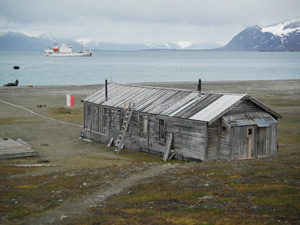 The wooden hut was put up in 1918 by Northern Exploration Company. The Polish flag is hung up by scientists who sometimes uses the hut in Calypsobyen. (Image: Øystein Overrein / The Norwegian Polar Institute) The wooden hut was put up in 1918 by Northern Exploration Company. The Polish flag is hung up by scientists who sometimes uses the hut in Calypsobyen. (Image: Øystein Overrein / The Norwegian Polar Institute)
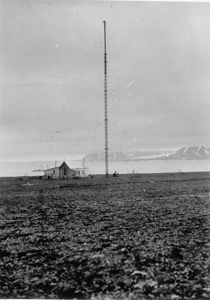 The telegraph mast in 1921. Though no longer standing, it remains an important component of the cultural legacy of the site. (Image: Anders K. Orvin / The Norwegian Polar Institute) The telegraph mast in 1921. Though no longer standing, it remains an important component of the cultural legacy of the site. (Image: Anders K. Orvin / The Norwegian Polar Institute)
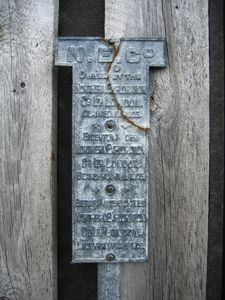 This annexation sign is still standing in Calypsobyen, reminding people of the glory days of the NEC. (Image: Stein Tronstad / The Norwegian Polar Institute) This annexation sign is still standing in Calypsobyen, reminding people of the glory days of the NEC. (Image: Stein Tronstad / The Norwegian Polar Institute)
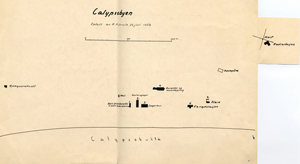 A sketch of the buildings in Calypsobyen when Orvin visited in July 1936. (Image: Anders K. Orvin / The Norwegian Polar Institute) A sketch of the buildings in Calypsobyen when Orvin visited in July 1936. (Image: Anders K. Orvin / The Norwegian Polar Institute)
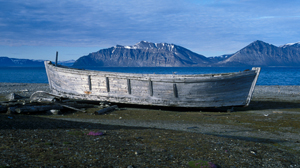 The barge on the beach is still nicely located even after nearly 100 years. (Image: Kristin Prestvold / The Governor of Svalbard) The barge on the beach is still nicely located even after nearly 100 years. (Image: Kristin Prestvold / The Governor of Svalbard)
The history of Calypsobyen
At Calypsostranda, on the southern shore of Bellsund, there is a cluster of buildings erected by the NEC in 1918-1919. The beach (Calypsostranda) and the cluster of buildings (Calypsobyen) were named after the HMS Calypso, which belonged to the British Navy Training Squadron that surveyed the area in 1895. Bellsund was one of the strongholds of the NEC’s activity at the beginning of the 20th century. Attempts were made to extract coal at Calypsostranda and in the years following World War I the NEC erected several buildings on the site to support the mining operations. At the time Calypsobyen housed the company’s headquarters.
The coal seam surfaces right on the beach, but the deposit soon proved too small. Calypsobyen is also very exposed to weather. Swells often wash directly onto the north-facing beach and there is no shelter. Landings and shipping of coal was almost impossible to carry out. Like many other NEC ventures, this one was also short-lived: it was shut down in 1920.
Brief description of the site:
- Camp Jacobsen (also called Strandhuset and Michelsenhuset) was built for the Christian Michelsen Mineral Expedition in 1901, making it the oldest building in Calypsobyen. The building was erected in the same period as the larger Michelsenhuset at Camp Morton. The building is one of the oldest ones connected to the history of mineral exploitation in Svalbard. The building was used as a main station for trappers for some seasons at the beginning of the 20th century, but was too expensive to heat due to its large size. On the hill behind the building Olav Sortevik, from Sortland, Norway, is buried. He was a trapper at Eholmen in the winter of 1908-1909 when he came down with scurvy. He was transported to Camp Jacobsen at Calypsostranda, where he died.
- In 1918 Birger Jacobsen built a trapper’s cabin that had nothing to do with the NEC installations. Ole Blomli later used the cabin for trapping every winter from 1930 until the evacuation of Svalbard in 1941.
- Buildings erected by the NEC in 1918-1919 include a type of barracks are the only examples still standing in Svalbard today, although they were widely used by the NEC at the time. Both the living quarters and the storage are elongated single-storey buildings with a saddle roof. The storage was originally a kitchen. Polish researchers have used the buildings every summer since 1986.
- There is a telegraph building erected by the NEC with a tall mast that has fallen over. The telegraph, a monument to the persistent optimism of the company, never became operational.
On the beach, a narrow gauge railway with carriages, several boat wrecks and a big barge are among the equipment left over from the mining era
Calypsobyen is one of the largest installations for coal mining in Svalbard, except for modern ones in operation today. In Calypsobyen there were a total of eight buildings of different age and function – six of them are still standing, even with some original furniture. For these reasons the installations have a significant historical value and also a high utility value today. Calypsobyen is on the Governor of Svalbard’s list of high priority cultural heritage sites. Substantial repairs were done in 1993, 1995 and 1998-1999. Smaller repairs have been undertaken in recent years.
Vulnerable elementsThe cultural remains and the Arctic terns close to the landing site are all vulnerable to human comings and goings. Landing sitesLand directly at the beach Calypsostranda, but avoid the railways and other cultural remains close to the shore. Be aware of nesting Arctic terns in and around the barge on the beach. Recommended trailsThe tundra behind Calypsobyen offers opportunities for a pleasant hike.
|